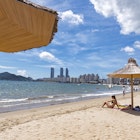
Mar 25, 2025 • 5 min read
Connect with the dynamic South Korean capital away from the bustle of business in the vibrant neighborhoods where its residents live, eat and unwind.

Mar 25, 2025 • 5 min read
Connect with the dynamic South Korean capital away from the bustle of business in the vibrant neighborhoods where its residents live, eat and unwind.

Feb 18, 2025 • 8 min read
From buses and bicycles to taxis and trains and your own two feet, read on for a guide to all the ways to get around Seoul.

Feb 13, 2025 • 3 min read
Find the ideal time for your visit to Seoul, the exciting South Korean capital, with this seasonal guide.

Aug 14, 2024 • 5 min read
The best places to eat and drink in Seoul, as recommended by a local.

Feb 17, 2024 • 6 min read
Stretch your budget in Seoul with these top money-saving tips and a guide to daily costs.

Feb 10, 2024 • 10 min read
Visiting Seoul on a budget? These temples, parks and viewpoints offer the best of the South Korean capital – for free.

Feb 3, 2024 • 6 min read
So over Seoul? Delve deeper into South Korea's history and culture with these day trips from the capital.

Aug 31, 2022 • 12 min read
Seoul is a foodie's playground. Here are our favorite restaurants serving up the best Korean dishes.

Jun 22, 2022 • 7 min read
Seoul has hundreds of museums – here’s a guide to navigating Seoul’s best ones, from the well-known and obvious to the niche, hidden gems.

Apr 18, 2022 • 6 min read
One of the world’s most dynamic cities has green spaces catering to couples, families, sports lovers and just about everyone. These are Seoul’s best parks.

Jan 27, 2020 • 5 min read
With K-Pop dominating pop culture everywhere around the world, this is the essential travel guide for fans wanting to explore the genre's homeland.

Sep 2, 2019 • 5 min read
South Korea's capital city is surrounded by mountains and coloured in with groves of trees – explore the foliage on our favourite autumn walks in Seoul.

Aug 16, 2019 • 6 min read
From a smoky jazz club in Paris to the throbbing beats of Berghain in Berlin, we've got the perfect round up of dream destinations for your musical tastes.

Mar 15, 2019 • 5 min read
Enjoy the delights of chimaek – Korean fried chicken paired with beer. Here are our picks for the best fried chicken restaurants in Seoul.

Oct 26, 2018 • 6 min read
From politicians to zany logos and cute animal prints, socks are a major trend in South Korea. Here's where to find your perfect pair of socks in Seoul.

Aug 9, 2018 • 5 min read
It’s 2am on a Saturday night in Seoul and the local watering hole is a packed house. You can hardly find a seat but eats are cheap and drinks are even…

Jan 4, 2018 • 5 min read
Quieted away, around the corner from one of South Korea's grandest hotels is a great food secret: Gwanghwamun Jip. Its worn-out blue sign gives away the…

Dec 8, 2017 • 4 min read
Lonely Planet Local Hahna Yoon talks about her favorite hidden bars and hole-in-the-wall local restaurants in Seoul.

Aug 31, 2016 • 5 min read
Prohibition might not have happened in South Korea, but US-inspired speakeasies are no relic of the past in Seoul.

Aug 28, 2015 • 4 min read
The term 'street art' can often conjure up an image of hooded graffiti-artists stenciling edgy pieces down seedy city laneways in the dark of the night.

Oct 21, 2014 • 6 min read
3am. Stars hover over a misty mountain temple. A gong sounds, rousing you from sleep on a thin floormat.

Sep 3, 2010 • 4 min read
Seoul is transformed every decade by its citizens’ energy and love of the new. Here's how to spend a perfect day in the capital of South Korea.